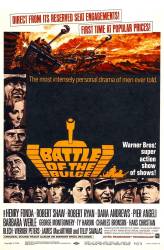Corrected entry: Sgt. Guffy is shown with Lucky Strike cigarettes in a green carton. At the beginning of WW2 an ingredient in the green dye was determined to be necessary for war production. The carton was changed to white & red; "Lucky Strike Green Goes to War" as the advertisement said. Since the Battle of the Bulge was in Dec. 1944 it is doubtful cigarettes that were 3 years old would still be around.
Corrected entry: The panzergrenadier commander, Major von Diepel, wears the double-breasted field grey uniform that was only worn by panzer artillery. Panzergrenadiers wore standard infantry uniform with green piping (which he does wear).
Correction: The panzergrenadier commander, Major von Diepel is in fact correctly wearing the infantry version of the panzer uniform in field gray issued to certain panzer-grenadier troops in 1944, particularly the Panzer Lehr elite Panzer Division.
Corrected entry: During the battle for Bastogne a German tank is coming over a wall. Two GIs place plastic explosives the size of bricks (and white), on the underside of the tank. Watch as the explosives are placed - they disappear, then they return again just before the explosion.
Correction: In the first sentence you mention the town of Bastogne. The scene you describe was actually during the battle of Ambeleve. It is the only scene in the entire movie where a town is being attacked. Also, the only scene at Bastogne was the scene where the Germans send out a messenger with an ultimatum, under a white flag of truce. He is subsequently blindfolded and taken to the American command post to deliver it.
Corrected entry: In the movie, all of the German soldiers are wearing Jackboots, tunics with scalloped pockets, and/or greatcoats. Yet due to material shortages, Tunic pockets were cut straight, and low boots with leggings were issued. As for winter gear, many soldiers were issued winter camouflage.
Correction: The cut-down uniforms were issued to new recruits, but longer-service soldiers would have continued to wear the old-style uniforms if they still had them.
Corrected entry: Lt. Col. Daniel Kiley is in the scout plane taking pictures of suspected German activity. He is using what I believe to be a "Speed Graphic" - a camera commonly used by the press for many years. The problem is the camera has no telephoto capability and could not have produced the photo of the German Colonel which was later shown.
Correction: The Anniversary model Speed Graphic had a detachable 10" telephoto lens. This particular camera and lens combo was used by Joe Rosenthal to snap his famous 'Flag Raising on Iwo Jima' picture in February 1945.






Correction: When I was stationed at Fort Gordon GA in 1970 we were issued cigarettes that were four years old. And early in WW2 American soldiers were issued rations from WW1.